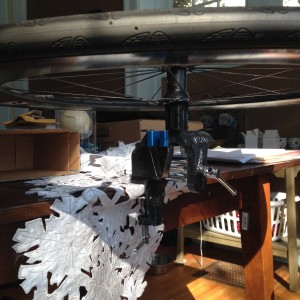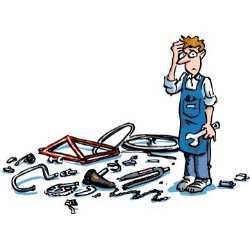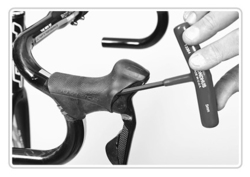Written by Becky Bader, Age-Group Triathlete and Former TriSports Elite Athlete
Before transitioning into IRONMAN triathlon, I spent many years racing bikes and occasionally working at bike shops in between jobs that some might consider to be more related to my Ph.D. When I quietly told my bike racing friends and fellow bike shop employees that I was moving to triathlon, I immediately prepared myself for the barrage of jokes related to poor bike handing skills and an inability to do something as simple as changing brake pads. I wish I could say that my years in triathlon have demonstrated to me that most triathletes are incredibly adept at maintaining their own bikes and that my bike racing friends were wrong in their perception. But I admit to being embarrassed for triathletes everywhere at some of the conversations about bikes I have overheard in the transition area before the start of IRONMAN.

Lesson 1: You have to start somewhere
We, of course, all have to start somewhere. I was fortunate enough to be taught how to ride by a former professional cyclist who, on the day that I purchased my first road bike, suggested to me that I had better get to a bike shop and figure out how to change a flat. Logically, I completely blew him off and then cursed his name as I took a slow walk of shame back to my car in my bike shoes after getting my first flat. So I went to the shop, purchased a set of tire levers, had the mechanics show me the best way to get a tire on and off of a wheel in order to replace the tube, and then practiced until I could change a flat in minimal time. I always suggest to beginners or novice triathletes that they take the time to ask a bike mechanic for a quick how-to lesson on things they might need to know out on the road.
Lesson 2: The right tools will go a long way
Many years, many bikes, and many bike shops later, I have come a long way from just being able to change a flat, and I can now build and maintain my own road and triathlon bikes. Contrary to popular belief, a vast amount of expensive tools are not necessary to get this done, and a complete set of hex wrenches can go a long way.
Lesson 3: An annual overhaul will keep your bike happy
As a rule of thumb, everything should be overhauled at least once per year (chain, cables, housing, and tires). If you are putting in some heavy mileage, I suggest investing in a quick chain checker, such as the Park Tool CC-2, to better gauge when you may need to replace the chain. This will save you from having to additionally invest in a new cassette more frequently. If you do need to change the chain, this is potentially the easiest do-it-yourself thing there is. You will need to invest in a chain tool; I use the Park Tool CT-3.2. After this purchase, changing the chain becomes somewhat self-explanatory. Simply press out one of the pins from the chain you are replacing with the tool, remove that chain, replace the chain, and insert a new pin using the tool again. Bear in mind that when you purchase a new chain, you will most definitely need to remove several links before putting on the new chain (all you need to do is compare the length of the new chain to the existing chain).
Lesson 4: Splurge on the cables and housing
Moving on to the internal routing of cables. Yes, I am willing to admit that this is a huge hassle, but still completely doable. I recommend ordering a complete set of cables and housing that is a little bit higher-end. Shimano makes great products that will keep you shifting cleanly for the entire year. Although cable cutters are obviously available at Lowes and Home Depot, the ones that are bike specific (such as Park Tool CN-10) will serve you much better. The key to internal routing is to take a string or dental floss and attach it to the end of the cable. If you do this to the old cable, you are left with a string that can be used to pull the new cable through the frame. Alternatively, you can simply attach the string or dental floss to the end of the new cable and then pull that through the frame using a vacuum cleaner (be careful that other holes in the bike are at least partially sealed). As for the housing, simply try to cut approximately the length of the housing that is being replaced.
Lesson 5: Fine-tuning your shifting will test your patience
Once the cables and housing have been replaced, getting things to shift correctly can be a tad more complicated. To set the front cable, simply put the shifter in the little ring and pull the cable as tight as possible before tightening the anchor bolt with a hex wrench. For the rear, do the same, but try to slowly shift up to the next biggest cog. If this does not occur, you are going to need to turn the barrel adjustor 1/4th of a turn counterclockwise until shifting occurs (make sure the barrel adjustor is fully turned in before tightening the anchor bolt). Repeat this process for the next cog, and eventually you will be back to a smoothly shifting bike. Slap on some new bar tape, and you are ready to roll.

A word of caution: if you continue down the path of maintaining your own bike, someday you may end up with your dining room table turned into a mount for an axle vice to change free hub bodies, and a living room where bike parts, tools, and bike part manuals cover every available surface. Good luck in keeping everything running smooth this season!



